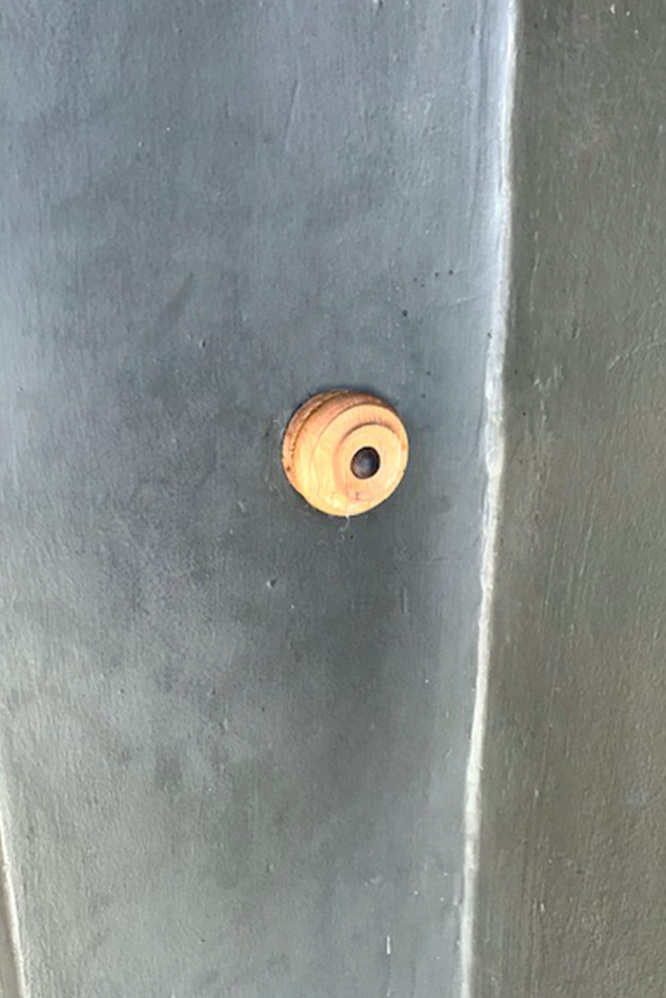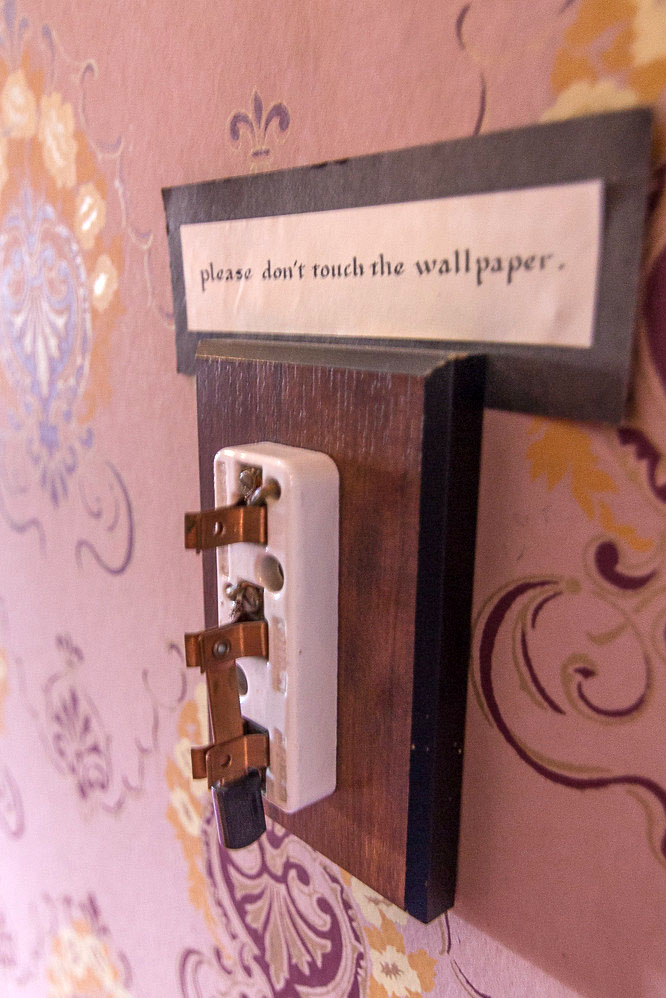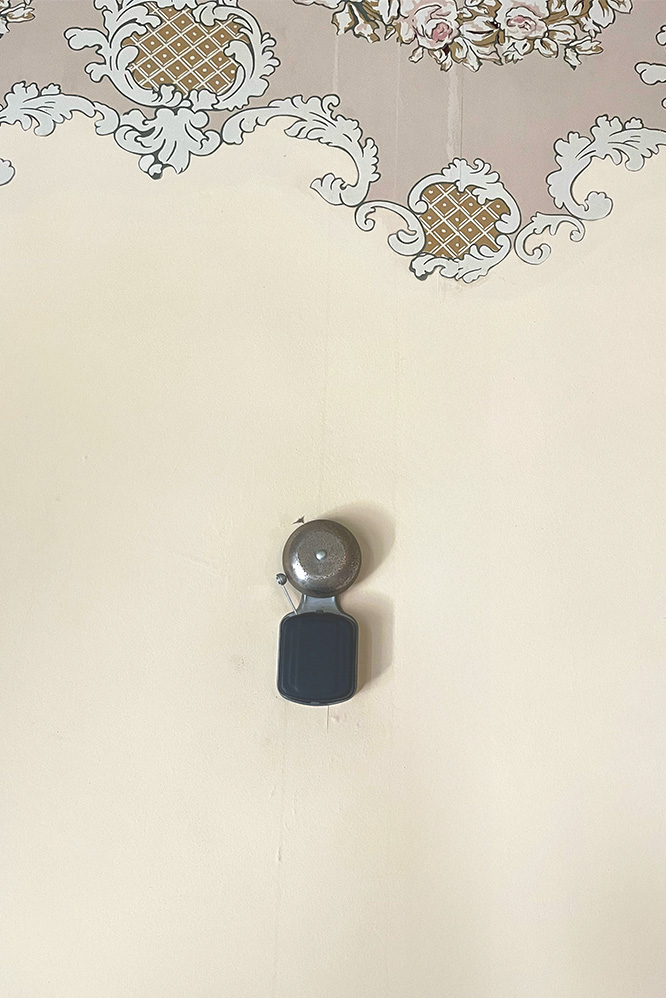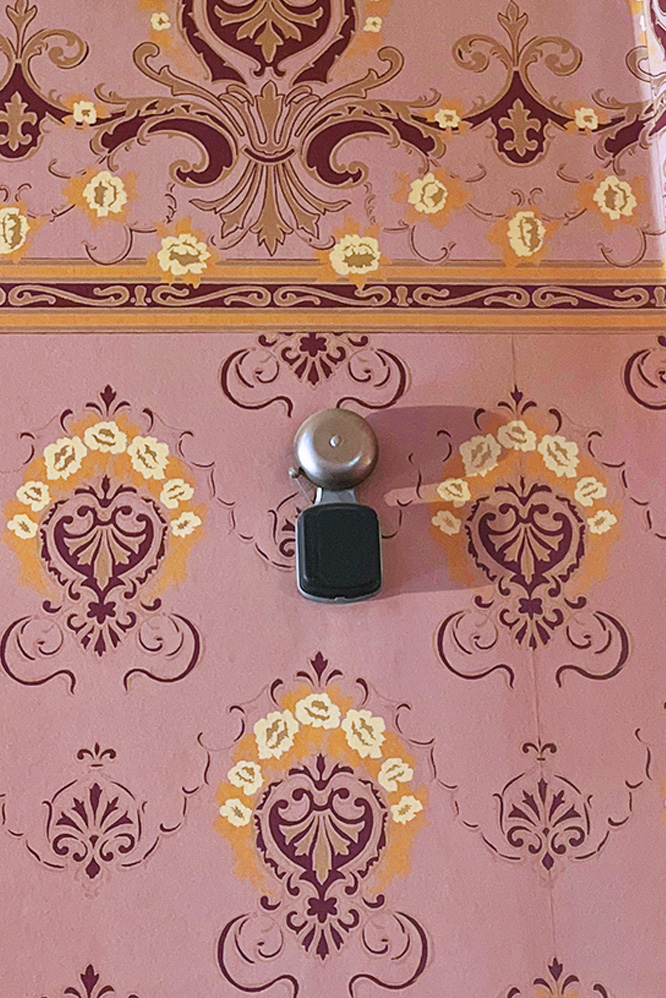Why did the scientist remove her doorbell?
She wanted to win the no-bell prize.
What do you call a skeleton who uses a door bell?
A dead ringer.
Changing Chimes: A Short History of the Doorbell
Posted August 1, 2025
Written by Heather Roberts, Research Historian
Did you know…

Sketch of the Rosson House doorbell system by restoration contractor Robert Heidel, 1978.
One of the more interesting finds during restoration of Rosson House were the wires beneath several layers of wallpaper in the front bedroom of the home. A little detective work revealed the wires had been used for a doorbell, thought to have been installed so that Dr. Rosson could be alerted at night if a patient needed him. The doorbell was powered by batteries, which were found under the floorboards during restoration, and was originally connected to the downstairs doorbell with a switch. With the way the two doorbells were wired, the switch would allow either one or the other to ring, but not both.
By the time Rosson House was built with its unique two-doorbell system, the electric doorbell had been around for over sixty years – invented in 1831 by Joseph Henry, the first secretary of the Smithsonian, and first patented by Robert Edwards and Adam Lünger in 1881 – and mechanical bells systems had existed for even longer.
-
Not The Only One
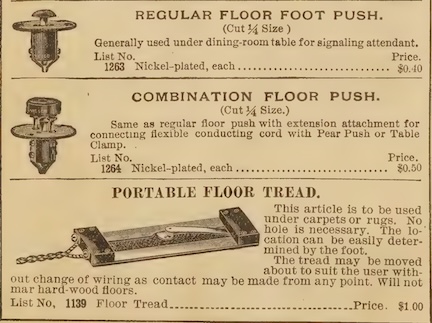 The doorbell wasn’t the only bell system Rosson House once had. When the Higleys lived at the home, they used the back parlor as their dining room, and installed a service bell there. A push-button was located in the floor, approximately four feet inside the door to the hallway, and would ring a bell in the kitchen. This type of bell was meant to be pressed by someone’s foot, like the ones seen here from the 1905 Manhattan Electrical Supply Co. catalog. People could install a single-bell system like the Higley’s, or something much more complicated like you might have seen in an episode of Downton Abbey.
The doorbell wasn’t the only bell system Rosson House once had. When the Higleys lived at the home, they used the back parlor as their dining room, and installed a service bell there. A push-button was located in the floor, approximately four feet inside the door to the hallway, and would ring a bell in the kitchen. This type of bell was meant to be pressed by someone’s foot, like the ones seen here from the 1905 Manhattan Electrical Supply Co. catalog. People could install a single-bell system like the Higley’s, or something much more complicated like you might have seen in an episode of Downton Abbey.Note: Rosson House didn’t really need an elaborate system of service bells like grander mansions had, but it did have one other way for the people who lived and/or worked there to communicate – a speaking tube.
Bells rung by hand had originally been used in the homes of the wealthy to alert servants. The first documented record of these types of bells being fixed to a wall was in in 1727 CE, in an inventory of Kiveton Hall in South Yorkshire, England. The bells were connected via a wire to a fabric pull or knob attached to a wall, and eliminated the need for a servant to be posted outside the family’s room around the clock to hear a bell rung in specific rooms. This type of system was soon adopted for front door use. (Watch this video about the call bells at historic Campbell House, built in 1851 and located in St. Louis, Missouri.)
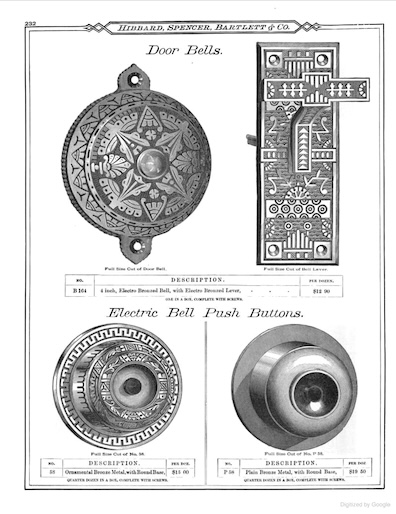 “Elizabeth had scarcely time to disclaim all right to the compliment, before their approach was announced by the door-bell…”
“Elizabeth had scarcely time to disclaim all right to the compliment, before their approach was announced by the door-bell…”
– from Pride and Prejudice (1813), by Jane Austen
The earliest mention of doorbells in American newspapers was in 1812, just a year before Pride and Prejudice was published with what is considered by some to be the first mention of doorbells in literature. But by the late 19th and early 20th centuries, the technology had advanced, and doorbells – both electrical and mechanical – were more commonplace for the middle and upper classes. Doorbells were available in general catalogs like Sears Roebuck and Montgomery Ward, as well as in trade catalogs for electrical businesses and those like the New Departure Bell Company, who specialized in making doorbells. The Hibbard, Spencer, Barlett & Co. catalog, where we’ve found the door hardware used in Rosson House, had both kinds of doorbells for sale.
Mechanical doorbells would attach either through an exterior wall or window, or through the door itself, with the knob, lever, or turn key on one side, and the bell on the other. When a visitor would press the lever or turn the knob or key, the bell would sound. (You can read more about mechanical doorbells, and hear how one sounds from the House of Antique Hardware.)
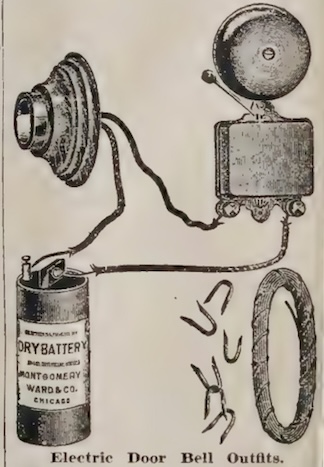 Electric doorbells, like the one originally at Rosson House, were at first powered by batteries. The use of a battery meant that if a home didn’t have electricity, or if the electricity wasn’t consistent – as most electricity wasn’t at that time – the doorbell could still be used. We know that the upstairs bell at Rosson House was removed fairly early in the life of the home, as there were several layers of wallpaper over the plaster patch that covered the hole for the wires, but only one layer of wallpaper underneath. Our guess is that it’s likely the Goldbergs removed the doorbell there, since they had no wish or need to be woken in the middle of the night by someone looking for a doctor. Restoration contractor, Robert Heidel, also theorized that the bell wouldn’t have worked very well, and believed that it was eliminated due to problems with the current, saying, “the original joints in the wire were not soldered, and the lime in the plaster (would) cause them to lose their conductivity at the splices.” (Image to the right: Electric door bell, sold with battery, wiring, pushbutton, and bell, 1908 Montgomery Ward catalog.)
Electric doorbells, like the one originally at Rosson House, were at first powered by batteries. The use of a battery meant that if a home didn’t have electricity, or if the electricity wasn’t consistent – as most electricity wasn’t at that time – the doorbell could still be used. We know that the upstairs bell at Rosson House was removed fairly early in the life of the home, as there were several layers of wallpaper over the plaster patch that covered the hole for the wires, but only one layer of wallpaper underneath. Our guess is that it’s likely the Goldbergs removed the doorbell there, since they had no wish or need to be woken in the middle of the night by someone looking for a doctor. Restoration contractor, Robert Heidel, also theorized that the bell wouldn’t have worked very well, and believed that it was eliminated due to problems with the current, saying, “the original joints in the wire were not soldered, and the lime in the plaster (would) cause them to lose their conductivity at the splices.” (Image to the right: Electric door bell, sold with battery, wiring, pushbutton, and bell, 1908 Montgomery Ward catalog.)
None of today’s bell system components at Rosson House (seen above) are original to the home, as they were likely replaced decades before restoration began. On the exterior is an antique pushbutton, however, with a turned wood frame – made in 2016 by local wood artist, Jim Beaman, after the previous version was broken during a festival. The interior pieces are either antiques or facsimiles thereof, purchased during the restoration process. And though it would be neat to hear the sound of an antique doorbell ringing through the house as it did in 1895, it would also be very distracting during tours, so the bell is not connected to electricity.
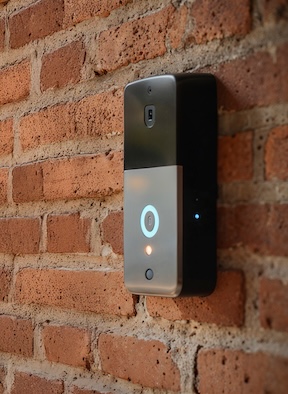 Today’s doorbells can work wirelessly, using Bluetooth and WIFI technology. The invention of the smart doorbell in 2012 – which combines a doorbell with a camera, motion detector, microphone, and speaker – has had just as significant an impact on doorbells as Joseph Henry’s invention over 180 years prior. Though security is a significant factor in the purchase of smart doorbells – and privacy is a factor in not purchasing them – they also offer added convenience, independence, and accessibility for older adults and those with mobility or accessibility needs. According to an article by AARP, approximately 20% of Americans (equaling 28 million households) had smart doorbells by the end of 2023.
Today’s doorbells can work wirelessly, using Bluetooth and WIFI technology. The invention of the smart doorbell in 2012 – which combines a doorbell with a camera, motion detector, microphone, and speaker – has had just as significant an impact on doorbells as Joseph Henry’s invention over 180 years prior. Though security is a significant factor in the purchase of smart doorbells – and privacy is a factor in not purchasing them – they also offer added convenience, independence, and accessibility for older adults and those with mobility or accessibility needs. According to an article by AARP, approximately 20% of Americans (equaling 28 million households) had smart doorbells by the end of 2023.
-
Reference List:
Cook, James E. “Clues in the Woodwork.” The Arizona Republic, 9 Oct. 1977, pp. 8–14 (Arizona insert), www.newspapers.com/image/117966171/.
“Doorbells Have Evolved from a Simple Knocking Device to High Tech.” Cleveland, 5 Aug. 2017, www.cleveland.com/homeideas/2017/08/doorbells_have_evolved_from_a.html. Accessed 10 June 2025.
Driggs, John. “Interview: Restoration of Rosson House.” The Square PHX Museum Collection, 8 June 2012.
Gross, Linda. “Bells Are Ringing: How to Call Your Servant “Downton Abbey” Style.” Hagley Museum and Library, 29 Apr. 2016, www.hagley.org/ru/about-us/news/published-collections-bells-are-ringing. Accessed 10 June 2025.
Heidel, Robert. Rosson House Notes. The Square PHX, 1 June 1978.
Lane, Jessie Jean. “Interview with J.J. Lane at Rosson House.” The Square PHX Museum Collection, 12 May 1977.
Madill, Wendy Danielle. “”Noiseless, Automatic Service:The History of Domestic Servant Call Bell Systems in Charleston, South Carolina, 1740-1900.” All Theses, TigerPrints, Clemson University, 2013, www.tigerprints.clemson.edu/all_theses/1660. Accessed 9 June 2025.
National Historic Chemical Landmarks Program of the American Chemical Society. The Columbia Dry Cell Battery. American Chemical Society, 2005, www.acs.org/education/whatischemistry/landmarks/drycellbattery.html. Accessed 13 June 2025.
National Museum of American History – Behring Center. Model of Joseph Henry’s Electromagnetic Bell. Smithsonian, 2024, www.americanhistory.si.edu/collections/object/nmah_890915. Accessed 10 June 2025.
Oxford English Dictionary. Doorbell Meanings, Etymology and More. 2024, www.oed.com/dictionary/doorbell_n?tl=true. Accessed 10 June 2025.
“Servant Bells at Poplar Forest.” Thomas Jefferson’s Poplar Forest, Feb. 2016, www.poplarforest.org/servant-bells-at-poplar-forest/. Accessed 9 June 2025.
Archive
-
2025
-
November (1)
-
October (1)
-
September (1)
-
August (1)
-
June (1)
-
May (2)
-
April (1)
-
January (1)
-
-
2024
-
December (1)
-
November (1)
-
October (1)
-
September (1)
-
August (1)
-
July (1)
-
June (1)
-
May (1)
-
April (1)
-
March (1)
-
February (1)
-
January (1)
-
-
2023
-
December (1)
-
November (1)
-
October (1)
-
September (1)
-
August (1)
-
July (1)
-
June (1)
-
May (1)
-
April (1)
-
March (1)
-
February (1)
-
January (1)
-
-
2022
-
December (1)
-
November (1)
-
October (1)
-
September (1)
-
August (1)
-
July (1)
-
June (1)
-
May (1)
-
April (1)
-
-
2021
-
December (1)
-
November (1)
-
October (1)
-
September (1)
-
August (1)
-
July (1)
-
June (1)
-
May (1)
-
April (1)
-
March (1)
-
February (1)
-
January (1)
-
-
2020
-
December (1)
-
November (1)
-
October (1)
-
September (1)
-
August (1)
-
July (1)
-
June (1)
-
May (1)
-
April (1)
-
March (1)
-
February (1)
-
January (1)
-
-
2019
-
December (1)
-
November (1)
-
October (1)
-
September (1)
-
August (1)
-
July (1)
-
June (1)
-
May (1)
-
April (1)
-
March (1)
-
February (1)
-
January (1)
-
-
2018
-
December (1)
-
November (1)
-
October (1)
-
September (1)
-
August (1)
-
July (1)
-
May (1)
-
April (1)
-
March (1)
-
February (1)
-
January (1)
-
-
2017
-
December (1)
-
November (1)
-
October (1)
-
September (1)
-
August (1)
-
July (1)
-
June (1)
-
May (1)
-
April (1)
-
March (1)
-
February (1)
-
-
2016
-
2015
-
2014
-
July (1)
-

